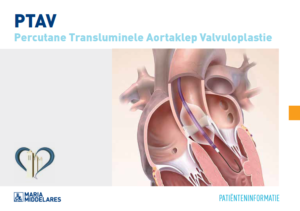Unblocking or widening of a heart valve
What is it?
What is it?A narrowed valve can be widened using the single-balloon (for the aortic valve) or the double-balloon (for the mitral valve) technique. This results in reduction of the gradient of the treated valve.
What is the process?
What is the process?Preparation
This procedure is always performed after admission or after consultation. You need to have fasted before the day of your admission. This means only clear liquids (e.g. only water, tea, and coffee) for a minimum of two hours beforehand. You may eat a light meal and consume dairy products no later than of six hours beforehand, and a normal meal no later than eight hours before admission. Your physician will tell you which medication you may take prior to the procedure.
You will first be admitted to the day hospital. If no recent laboratory results are available, blood samples will be collected. An electrocardiogram will be done too.
You will be given a surgical gown to wear. Shortly before the procedure, you can be provided with a tablet to help you relax. The nurse places an IV line in your arm for the administration of medication, should that be necessary.
Procedure
The procedure is performed in the cardiac catheterisation room where you take place on the treatment table. Adhesive electrodes are attached to monitor your heart rhythm.
Balloon dilatation of the aortic valve
This procedure is generally performed under a local anaesthetic. Two tubes are inserted through the groin (one in the artery and one in the vein). A temporary pacemaker is placed that is removed again after the procedure. A stiff guide wire is threaded through the tube in the artery up to the narrowed heart valve. Then, a balloon, or sometimes a series of balloons, is threaded over the wire to dilate the heart valve.
Balloon dilatation of the mitral valve
This procedure is performed under general anaesthetic. The procedure is done in conjunction with a transoesophageal echocardiography. Through a tube in the groin (in the vein), a long needle is inserted and passed through the partition from the right to the left atrium. A long catheter is subsequently introduced. A thin wire is threaded up to the narrowed mitral valve and two balloons are used to open the valve.
Aftercare
You will be closely monitored in the Cardiac Care Unit during the first 24 hours after the procedure. After your discharge, further monitoring will take place through consultations in which possible follow-up treatment is discussed.
What are the risks?
What are the risks?Because of the selection process preceding the procedure and careful monitoring of the different stages of the treatment, complications are very rare. Some complications may require urgent surgery. The most important complications are:
- Groin bleeds
- Embolism
- Atrial septal defect
- Valvular insufficiency
- Rupture of the valve ring
- Cardiac tamponade
Results
ResultsBalloon dilatation of the aortic valve rarely delivers a permanent result and is, for instance, considered as temporary treatment of recurrent decompensation due to critical aortic stenosis, or as bridging therapy before definitive therapy (surgical or percutaneous).
Balloon dilatation of a mitral valve generally delivers a permanent result. The success of the treatment is estimated in advance based on elements from the preliminary tests.
Leaflet
LeafletSee the leaflet below for more information.
Only available in Dutch:

Openen of dilateren van een hartklep
DownloadCentres and specialist areas
Centres and specialist areas
Something wrong or unclear on this page? Report it.
Latest publication date: 13/08/2024
Supervising author: Dr Provenier Frank




